Training of Trainers on Low-Carbon Materials: Stabilized Earth Brickmaking and Demonstration Building
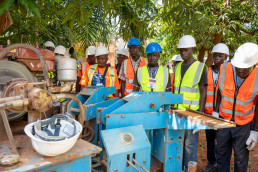
Photo credit: Aza Communications for UNDP Burkina Faso
The Programme organized a Training of Trainers on production of Stabilized Earth Bricks – a type of low-carbon material following the Africa Forum on Low-Carbon Materials and SAMAO 2024. During the training, 100 practitioners – artisanal miners, researchers, students and experts from Burkina Faso and guest delegates – put into practice the knowledge about low-carbon materials that they gained during the preceding Africa Forum.
The TOT put the spirit of South-South cooperation and knowledge sharing into practice, mobilizing a team of trainers comprised of experts from Cameroon, an expert from Nigeria, locally available expertise from Burkina Faso – engineers, architects, researchers and practitioners.
The TOT combined theoretical and practical training.
During a 3-day theoretical training, experts guided participants through Stabilized Earth Bricks (SEB) construction techniques, sustainability challenges, and the role of Development Minerals in the economy. To set the tone, a documentary on Djenné – a world heritage site − showcased earthen architectural heritage, a historical masterpiece of traditional Sahelian architecture typical to Mali, Burkina Faso and Niger. Participants then were guided to design a model building.
The remaining two weeks were dedicated to the practical training on the premises of the General Directorate of Quarries. During this hands-on training, the participants learned and practiced production of Stabilized Earth Bricks under a supervision by experts from the Programme and Cameroon. They produced nearly 6,000 stabilized earth bricks.
Overall, participants learned making Stabilized Earth Bricks, which is one type of low-carbon materials, and elements of earth construction techniques, how to organize and manage a production unit, and business approaches. The training provided valuable skills for value-addition to Development Minerals to learners within a short period, using minerals available in abundance locally, with quality techniques and low-cost production processes.
The training culminated in construction of a demonstration building as an added asset for promoting the value of low-carbon building materials and raising awareness about the potential for skills development for youth. The building was constructed on the premises of the Directorate General of Quarries (DGC) of the Ministry of Energy, Mines and Quarries.
The prototype low-carbon materials building aims to demonstrate opportunities in using local materials, technical expertise and indigenous knowledge, to build buildings that can meet different purposes – from office buildings to social housing that can be scaled up in the future, to meet the demand for public infrastructure and housing in fast-growing African nations.
The Training of Trainers also promoted cultural heritage, local materials and indigenous knowledge of women painters from Kassena ethnic group from Tiébélé in Burkina Faso, who adorned the building with their traditional mural art.
West African Mining Week (SAMAO 2024)

The Sixth Edition of the West African Mining Week (SAMAO 2024) on the theme “Critical minerals: What development strategies for African countries?” was organized by the Government of Burkina Faso with the aim to promote the mining sector. The SAMAO 2024 brought together over 2000 delegates from sixteen countries Burkina Faso, Belgium, Cameroon, Chad, Côte d’Ivoire, Congo-Brazzaville, Demographic Republic of Congo, Ethiopia, Guinea, Niger, Nigeria, Mali, Senegal, Togo, Uganda and Zambia.
During a session dedicated to Development Minerals, the Programme brought together a panel of experts to explore the potential of construction materials in Burkina Faso and more widely in the region. The panel addressed topics such as energy saving, architectural designs, climate change mitigation, and the role of low carbon materials, fostering insightful discussions and knowledge exchange. SAMAO 2025 showcased the importance of Development Minerals in driving sustainable and eco-friendly construction.
In a forum dedicated to large scale mining of gold and other metals, the participation has created visibility for Development Minerals, and their contribution to local, sustainable economic development, underscored through steady participation since the second edition of SAMAO. During this recent, sixth edition, artisanal and small-scale mining (ASM) of Development Minerals took center stage in discussion of ASM issues.
From their potentials to the versatile uses including low-carbon materials for infrastructure development and construction, the unique versatility of these materials and how the Programme is working to promote them in the ACP regions showcased economic diversification opportunities while responding to climate challenges through low-carbon materials promotion. The session contributed to shaping the narrative in mining for development. The final communiqué of SAMAO included several sector development measures, including formalisation and value addition.
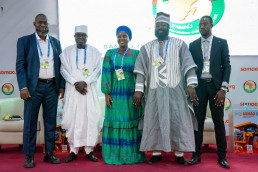
Photo credit: UNDP Burkina Faso
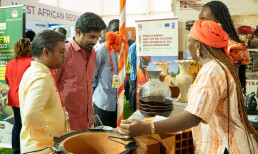
Photo credit: UNDP Burkina Faso
Africa Forum on Low-Carbon Materials and Value Addition to Development Minerals
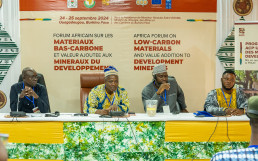
Photo credit: UNDP Burkina Faso
The Africa Forum on Low-Carbon Materials and Value Addition to Development Minerals was held in Ouagadougou, Burkina Faso from 24th to 25th September, 2024. It was organized by UNDP, implementing the ACP-EU Development Minerals Programme, under the auspices of the Government of Burkina Faso and in association with the West Africa Mining Week (SAMAO 2024).
The Forum brought together nearly 200 national and international participants, who came to share their expertise and experiences. The Forum was attended by delegates/representatives from governments, artisanal small-cale mining sector (ASM), mining companies, construction companies, academia, researchers and trainers from Burkina Faso, Cameroon, Guinea, Nigeria, Senegal, Togo, as well as online speakers from Ethiopia, and Germany.
The Forum discussed ways in which businesses and artisanal and small-scale miners collaborate with governments and researchers to add value to Development Minerals to produce construction materials that use local materials and create jobs and wealth. The Forum also raised awareness about low-carbon construction materials that have less environmental footprint and lower greenhouse gas emissions compared with conventional construction materials and promoted alternative and sustainable materials. It advocated for using locally available resources to promote entrepreneurship among young people and women, and respond to the challenges of growing urbanization, while doing so in an environmentally sustainable manner.
Such entrepreneurship would start addressing critical challenges faced in Africa, such as facilitating access to decent housing, creation of decent jobs, climate action and environmental protection, diversification of economic opportunities and the use of local materials, development of small and medium-enterprises, local content development, and the need for indigenous solutions for integrated development.
The Forum provided a unique opportunity for stakeholders from diverse countries to exchange good experiences in value-addition to minerals such as clays, sand, stone, laterites and volcanic materials, in production of low-carbon materials, in innovations and research in these materials, in building materials standards that embrace innovation and are suitable for climates in Africa, and in vocational training and higher education.
Bringing together international experts and ASM stakeholders, the Forum helped to raise knowledge and awareness on technical aspects of low-carbon materials, including research, manufacture and adoption of low-carbon materials, environmentally-friendly and socially-embedded architecture, and discussed the ways forward for the promotion and popularization of these materials.
The forum further explored opportunities for cross-country partnerships through skills development and training programs and provided an opportunity for networking and mentorship linkages.
Knowledge-Sharing Workshop on Challenges and Opportunities for the Development Minerals Sector
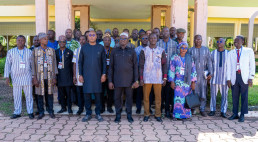
Photo credit: UNDP Burkina Faso
This workshop, dubbed the “pre-SAMAO workshop” contributed to the advancement of Burkina Faso’s Development Minerals sector. Jointly organized by the ACP-EU Development Minerals Programme, UNDP Burkina Faso, and the Ministry of Energy, Mines and Quarries, the event assembled 150 stakeholders and technical experts. It facilitated structured South-South knowledge transfer among ACP-EU Programme partner countries, targeting sectoral optimization through analytical discourse.
The primary objectives of the workshop centered on accelerating formalization of Artisanal and Small-Scale Mining Enterprises (ASMEs); value chain enhancement for Development Minerals; Environmental, Health, and Safety (EHS) standardization across community-impact operations; promotion of climate-resilient, economically viable alternative materials (e.g., Stabilized Earth Bricks for circular economy/zero-waste applications); and SME growth and employment generation, specifically addressing youth and women’s unemployment through sustainable enterprise models.
Technical sessions during the workshop focused on four domains:
- ASME formalization methodologies
- EHS best practices in mineral extraction and processing
- Circular economy Integration via stabilized earth brick production
- Sand value chain optimization for national economic integration
The workshop established a foundational technical dialogue preceding the 5th SAMAO Mining Conference, directly aligning with strategic imperatives for sectoral resilience, inclusive growth, and environmental governance within Burkina Faso’s development minerals landscape.
Presentations were made by the ACP-EU Development Minerals Programme (UNDP)’s staff, ASMEs from Cameroon, academia and researchers from the University of Dschang; regulators from the Republic of Congo, Burkina Faso and Tanzania, as well as the expert from UNEP-GRID Geneva. The highlights of the workshop were the practical demonstration sessions in making compressed earth bricks from laterite, demonstration of energy-efficient cooking stove from clay made in Cameroon, as well as technical guidance for production of clay pottery. The event also served as a platform to conduct training for trainers on environmental, health and safety issues, and on a zero-waste approach to laterite quarrying.
The workshop had strong ownership by the Ministry of Mines, Energy and Quarries, strong South-South collaboration orientation and vibrant exchanges. For the first time, artisanal miners, potters, policy makers and practitioners from across the four focus countries met in person to share knowledge on critical issues pertaining to the sector such as formalization, extension services, policy making as well as hands on training on value addition through knowledge transfer from Cameroon to new focus countries of the Programme. The workshop generated enormous interest from the participants from Burkina Faso, Cameroon, Chad, Congo Brazzaville and Tanzania.
Speaking of the pre-SAMAO workshop at the opening ceremony, the representative of the EU Delegation in Burkina Faso said that “supporting such an activity makes the organization proud…; several delegations will share their experiences; this is something that is very important”.
The Permanent Secretary of the Ministry of Energy, Mines and Quarries, Burkina Faso, said in closing: “In many jurisdictions, the legislative framework is geared towards issues relating to large-scale mining. Regulation of Artisanal and Small-Scale Mining (ASM) is often limited to title issues with very little provision for other aspects – from a sustainability and viability perspective. ASM has long been practiced as a source of income, and the process of formalization drive is beginning to emerge only now.” He also highlighted the importance of the African Mining Vision (AMV) in “creating a mining sector that exploits the potential of mining artisanal and small-scale to advance integrated and sustainable rural socio-economic development.”
Exploration des Richesses Minérales pour un Développement Durable : L'Engagement du PNUD au Burkina Faso
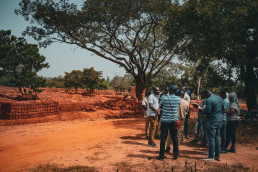
Le Burkina Faso, riche en ressources minérales, voit un nouvel élan dans la valorisation de ses carrières grâce à l’initiative “Minéraux du Développement” du Programme ACP-UE, soutenue par le PNUD. Une étape cruciale dans ce processus a été l’appui à la formation et à la formalisation des acteurs clés du Ministère des Mines et des Carrières.
Cette formation, dynamique et complète, a combiné théorie et pratique, s’aventurant sur trois sites distincts, chacun offrant un aperçu unique des ressources exploitées, des modes d’exploitation, et des surfaces/espaces exploités.
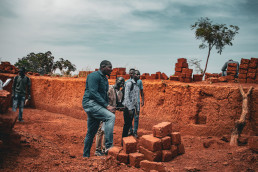
1. **Carrière Artisanale de Latérite de Toussiana :** Nichée sur l’axe Bobo-Banfora, cette carrière s’étend sur plus de 25 hectares, abritant une couche latéritique d’une épaisseur variant entre 1.8 et 2 mètres. Avec une exploitation judicieuse, elle pourrait produire environ 30 millions de briques de construction standard en fin d’exploitation.
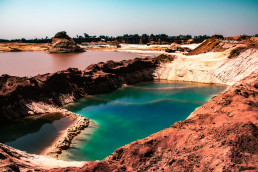
2. **Carrière Artisanale de Sable de Koro :** Située à la sortie Est de Bobo, cette carrière de sable couvre plus de 150 hectares, révélant une ressource impressionnante même en dehors de l’aire exploitée, avec une épaisseur moyenne de 20 mètres. Une estimation prudente suggère déjà plus de 15 millions de mètres cubes de sable exploités, avec un rendement d’environ 85%.
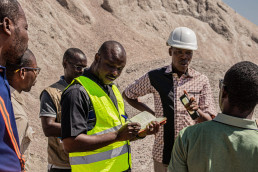
3.**Carrière Industrielle de Granite de Sogossagasso :** Exploitée par COGEB International, cette carrière de granite repose sur un affleurement de granitoïde, avec une capacité de production maximale estimée à 1000 tonnes par jour, située à environ 26 km de Bobo Dioulasso.
Les activités de recherche, d’évaluation et d’exploitation dans ce secteur complexe requièrent une expertise élevée, justifiant la tenue de cette formation à Bobo-Dioulasso, une région environnante regorgeant de plusieurs sites de “minéraux de développement”.
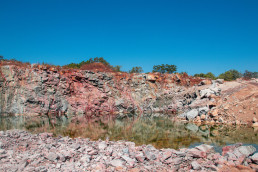
Dans cet effort continu pour valoriser les substances utiles et les matériaux de construction, l’organisation efficace du secteur émerge comme un impératif. Un tel alignement profiterait à toutes les parties prenantes, des exploitants au gouvernement et aux partenaires. Plus crucial encore, cette organisation contribuerait à préserver l’environnement, une nécessité cruciale dans le contexte actuel de changement climatique. Le PNUD au Burkina Faso trace ainsi une voie vers un développement durable, où les richesses minérales sont exploitées de manière éthique et éclairée pour le bénéfice de tous.
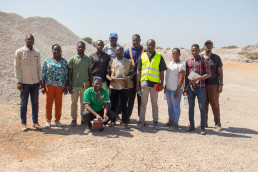
This story was originally published by PNUD Burkina Faso on November 21, 2023
Visite de courtoisie et discussion sur les pistes de renforcement des appuis du PNUD avec les autorités locales
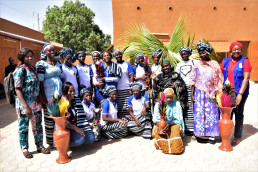
Photo credits: PNUD Burkina Faso
La commune de Tchériba a reçu, ce 13 février 2023, la visite de la représentante Résidente du PNUD au Burkina Faso, Dr Elsie Laurence-Chounoune. Elle y a échangé avec les autorités locales sur les interventions de l’agence, et avec les potières. Ces dernières ont saisi l’occasion pour réitérer leurs remerciements au PNUD, qui, avec un concours du Luxembourg, a mis à leur disposition un centre de commercialisation de leurs produits. Ce centre comporte 20 boutiques, des magasins et un restaurant, offrant à la centaine de femmes un cadre plus approprié pour mener leurs activités.
En plus de cette réalisation, le PNUD soutient actuellement, avec le FEM, la mise en œuvre, dans cette commune, du projet Assurance Climatique, qui permet aux producteurs de protéger leurs cultures contre les conséquences néfastes des chocs climatiques. Par ailleurs, Tchériba fait partie des communes bénéficiaires du Projet de Valorisation et de Renforcement de l’Exploitation Artisanale des Minéraux du Développement (PVREAMD), lancé en début décembre 2022, pour renforcer, entre autres, les capacités des potières. Dans le cadre du PAMED, le PNUD a enclenché l’aménagement d’une Ferme agroécologique polyvalente, en vue de contribuer à améliorer les moyens d’existence des populations, dont des Personnes déplacées internes (PDI).
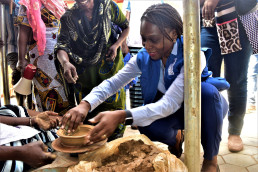
Photo credits: PNUD Burkina Faso
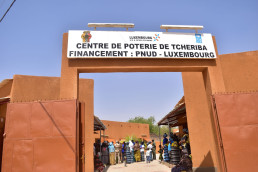
Photo credits: PNUD Burkina Faso
« Vous n’êtes pas seuls, vous pouvez continuer à compter sur le PNUD ». C’est ce message d’espoir que la Représente-Résidente (RR) du PNUD au Burkina Faso, Dr Elsie Laurence-Chounoune a partagé avec le gouverneur, les services techniques et les populations de la Boucle du Mouhoun, qu’elle a visités les 13 et 14 février 2023, dans le chef-lieu de région et quelques villages environnants.
Des moments pour la RR pour découvrir de visu les impacts des investissements déjà réalisés par le Programme et témoigner sa volonté de marquer davantage la présence du PNUD dans la région, selon les priorités définies par les autorités et populations locales.
A travers des projets arrivés à termes comme EBA-FEM, PAPCIDDEL, COLIBRIS et en cours comme PAMED, GOLCOS, Assurance Climatique, Minéraux du développement, le PNUD et ses partenaires ont contribué dans la région :
-
- Au renforcement des moyens de production des populations, grâce à des centres de transformation et de vente de produits locaux, des fermes de production agricole durable, des marchés à bétail, etc. ;
- À l’amélioration de la gouvernance locale, la promotion de la paix, l’accès des populations à la justice, aux documents d’état civile et à la santé, à travers l’appui pour l’élaboration de plans communaux de développement, de don de matériel informatique, de registres d’état civil, des équipements sanitaires, entre autres, au profit de plus d’une vingtaine de communes et de départements.
- La Représentante Résidente du PNUD, Dr Elsie Laurence-Chounoune, le Gouverneur de la Région du Centre-Ouest, Boubacar Nouhoun Traoré, ainsi que les Services Techniques Régionales en charge de l’eau, étaient sur le chantier du barrage de Niangdo, dans la commune de Poa, ce 14 février 2023. Ils sont allés constater l’état d’avancement des travaux. Du rapport de la structure en charge du contrôle, le taux d’exécution est de 80%.
La Représentante Résidente du PNUD, Dr Elsie Laurence-Chounoune, le Gouverneur de la Région du Centre-Ouest, Boubacar Nouhoun Traoré, ainsi que les Services Techniques Régionales en charge de l’eau, étaient sur le chantier du barrage de Niangdo, dans la commune de Poa, ce 14 février 2023. Ils sont allés constater l’état d’avancement des travaux. Du rapport de la structure en charge du contrôle, le taux d’exécution est de 80%.
Les visiteurs ont cependant regretté le retard accusé par l’entreprise en charge de la construction, et ont réaffirmé leur détermination à travailler pour que l’ouvrage puisse être prêt à recueillir les eaux de la saison pluvieuse de l’année en cours.
En attendant, les futurs bénéficiaires nourrissent beaucoup d’espoir avec ce barrage de 580 000m3, qui à terme, permettra de mener, en continu, des activités agro-sylvo-pastorales, et de lutter contre la pauvreté. Pour eux, ce fruit d’une coopération triangulaire entre le Burkina Faso, l’Inde et le PNUD, augure la naissance d’un véritable pôle de développement dans la commune de Poa.
Les investissements du PNUD dans la Boucle du Mouhoun est évalué à plus de 3,6 milliards de F CFA, ces 5 dernières années. Le Programme compte faire mieux, assure la RR.
This story was originally published by PNUD Burkina Faso on February 6, 2023
